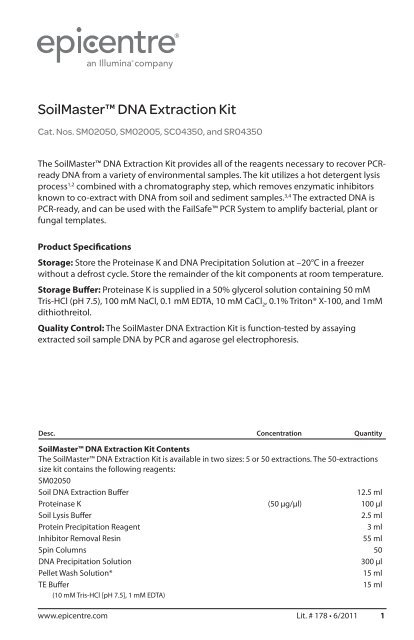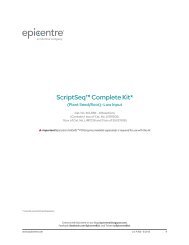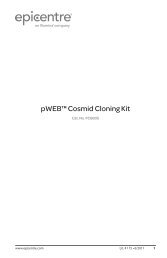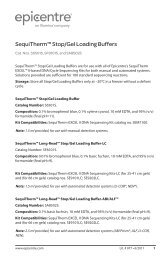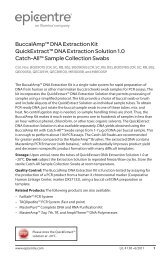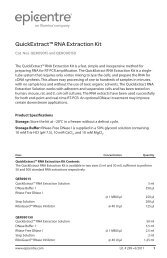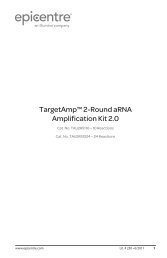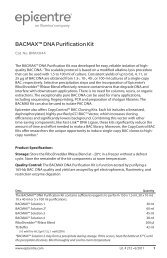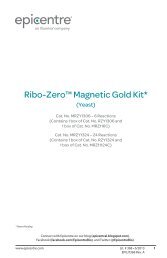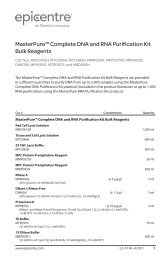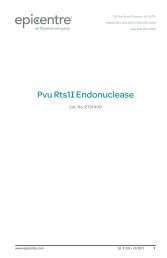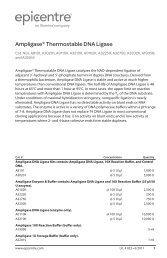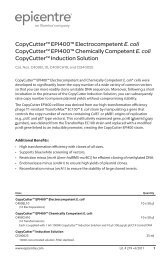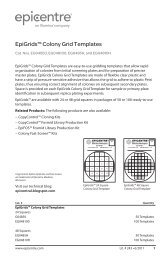Protocol for SoilMaster⢠DNA Extraction Kit
Protocol for SoilMaster⢠DNA Extraction Kit
Protocol for SoilMaster⢠DNA Extraction Kit
You also want an ePaper? Increase the reach of your titles
YUMPU automatically turns print PDFs into web optimized ePapers that Google loves.
SoilMaster <strong>DNA</strong> <strong>Extraction</strong> <strong>Kit</strong><br />
Cat. Nos. SM02050, SM02005, SC04350, and SR04350<br />
The SoilMaster <strong>DNA</strong> <strong>Extraction</strong> <strong>Kit</strong> provides all of the reagents necessary to recover PCRready<br />
<strong>DNA</strong> from a variety of environmental samples. The kit utilizes a hot detergent lysis<br />
process 1,2 combined with a chromatography step, which removes enzymatic inhibitors<br />
known to co-extract with <strong>DNA</strong> from soil and sediment samples. 3,4 The extracted <strong>DNA</strong> is<br />
PCR-ready, and can be used with the FailSafe PCR System to amplify bacterial, plant or<br />
fungal templates.<br />
Product Specifications<br />
Storage: Store the Proteinase K and <strong>DNA</strong> Precipitation Solution at –20°C in a freezer<br />
without a defrost cycle. Store the remainder of the kit components at room temperature.<br />
Storage Buffer: Proteinase K is supplied in a 50% glycerol solution containing 50 mM<br />
Tris-HCl (pH 7.5), 100 mM NaCl, 0.1 mM EDTA, 10 mM CaCl 2<br />
, 0.1% Triton® X-100, and 1mM<br />
dithiothreitol.<br />
Quality Control: The SoilMaster <strong>DNA</strong> <strong>Extraction</strong> <strong>Kit</strong> is function-tested by assaying<br />
extracted soil sample <strong>DNA</strong> by PCR and agarose gel electrophoresis.<br />
Desc. Concentration Quantity<br />
SoilMaster <strong>DNA</strong> <strong>Extraction</strong> <strong>Kit</strong> Contents<br />
The SoilMaster <strong>DNA</strong> <strong>Extraction</strong> <strong>Kit</strong> is available in two sizes: 5 or 50 extractions. The 50-extractions<br />
size kit contains the following reagents:<br />
SM02050<br />
Soil <strong>DNA</strong> <strong>Extraction</strong> Buffer<br />
12.5 ml<br />
Proteinase K (50 μg/μl) 100 μl<br />
Soil Lysis Buffer<br />
2.5 ml<br />
Protein Precipitation Reagent<br />
3 ml<br />
Inhibitor Removal Resin<br />
55 ml<br />
Spin Columns 50<br />
<strong>DNA</strong> Precipitation Solution<br />
300 μl<br />
Pellet Wash Solution*<br />
15 ml<br />
TE Buffer<br />
15 ml<br />
(10 mM Tris-HCl [pH 7.5], 1 mM EDTA)<br />
www.epicentre.com Lit. # 178 • 6/2011 1
SoilMaster <strong>DNA</strong> <strong>Extraction</strong> <strong>Kit</strong><br />
Related Products: The following products are also available:<br />
– MasterPure Complete <strong>DNA</strong> and RNA Purification <strong>Kit</strong><br />
– MasterPure <strong>DNA</strong> Purification <strong>Kit</strong><br />
– MasterPure RNA Purification <strong>Kit</strong><br />
– MasterPure Plant Leaf <strong>DNA</strong> Purification <strong>Kit</strong><br />
– MasterPure Yeast <strong>DNA</strong> Purification <strong>Kit</strong><br />
– FailSafe PCR System<br />
– MasterAmp PCR Optimization <strong>Kit</strong>s<br />
– MasterAmp Taq, Tth, Tfl, and AmpliTherm <strong>DNA</strong> Polymerases<br />
– BuccalAmp <strong>DNA</strong> <strong>Extraction</strong> <strong>Kit</strong><br />
*Note: Ethanol must be added to the Pellet Wash Solution be<strong>for</strong>e its first use (see Preparation<br />
of Pellet Wash Solution on page 3).<br />
If a cap is desired <strong>for</strong> later spins of the column, the original cap can be cut off its tube and<br />
substituted <strong>for</strong> the cap of other 1.5-ml tubes.<br />
General Considerations<br />
1. Sample Sources: We have used this kit to isolate PCR-ready <strong>DNA</strong> from a variety of<br />
soil and sediment sources including: <strong>for</strong>est soil, marsh soil, garden soil and cave<br />
sediment. Due to the wide variety of organic contaminants in different soil samples,<br />
some optimization of the initial sample size used and the amount of extract loaded<br />
onto the spin column may be required.<br />
2. Sample Size: Generally 100 mg of soil will provide 300 μl of PCR-ready <strong>DNA</strong>. Users<br />
can extract <strong>DNA</strong> from larger sample sizes by using multiple spin columns. Do not<br />
load more than 150 μl of extract on a column.<br />
3. Quantitation of <strong>DNA</strong>: If necessary, the concentration of PCR-ready <strong>DNA</strong> extracted<br />
by the SoilMaster <strong>DNA</strong> <strong>Extraction</strong> <strong>Kit</strong> should be measured by comparison to a<br />
standard amount of genomic <strong>DNA</strong> run side-by-side on an agarose gel. The remaining<br />
organic compounds co-extracted with the <strong>DNA</strong> may interfere with fluorimetry and<br />
spectrophotometry.<br />
Soil <strong>DNA</strong> Purification <strong>Protocol</strong><br />
A. Preparation:<br />
Spin Columns<br />
1. Add 550 μl of Inhibitor Removal Resin to each empty Spin Column to be used.<br />
Centrifuge <strong>for</strong> 1 minute at 2000 x g to pack the column.<br />
2. Decant flow-through and place the column in the same collection tube.<br />
3. Add another 550 μl of Inhibitor Removal Resin to each packed column. Centrifuge <strong>for</strong><br />
2 minutes at 2000 x g.<br />
4. Move the column to a clean 1.5-ml collection tube.<br />
2 www.epicentre.com
SoilMaster <strong>DNA</strong> <strong>Extraction</strong> <strong>Kit</strong><br />
Soil or Sediment Sample<br />
Extract and lyse cells<br />
Spin down soil matrix<br />
Soil Pellet<br />
Retain supernatant<br />
Protein Pellet<br />
Precipitate and<br />
spin down proteins<br />
Retain supernatant<br />
Spin Column<br />
Remove PCR inhibitors<br />
Discarded Column<br />
Retain flow through<br />
Precipitate <strong>DNA</strong><br />
Resuspend <strong>DNA</strong><br />
Figure 1. An overview of the process <strong>for</strong> extraction of <strong>DNA</strong> from soil samples.<br />
techhelp@epicentre.com • (800) 284-8474 3
SoilMaster <strong>DNA</strong> <strong>Extraction</strong> <strong>Kit</strong><br />
Pellet Wash Solution<br />
1. For 50 <strong>Extraction</strong>s <strong>Kit</strong>: Add 45 ml of ethanol to the Pellet Wash Solution be<strong>for</strong>e first use.<br />
For 5 <strong>Extraction</strong>s <strong>Kit</strong>: Add 4.5 ml of ethanol to the Pellet Wash Solution be<strong>for</strong>e first use.<br />
B. Cell Lysis:<br />
1. Weigh out 100 mg of the soil sample into a 1.5 ml tube.<br />
2. Add 250 μl of Soil <strong>DNA</strong> <strong>Extraction</strong> Buffer and 2 μl of Proteinase K; vortex briefly.<br />
3. (Optional) To increase the yield of <strong>DNA</strong>, shake the tube at 37°C <strong>for</strong> 10 min. or vortex<br />
<strong>for</strong> 2 min.<br />
Note: vortexing may shear the <strong>DNA</strong>.<br />
4. Add 50 μl of Soil Lysis Buffer and vortex briefly.<br />
5. Incubate at 65°C <strong>for</strong> 10 minutes.<br />
6. Centrifuge <strong>for</strong> 2 minutes at 1000 x g.<br />
7. Transfer 180 μl of the supernatant to a new tube.<br />
8. Add 60 μl of Protein Precipitation Reagent, mix thoroughly by inverting the tube.<br />
9. Incubate on ice <strong>for</strong> 8 minutes. Centrifuge the tube <strong>for</strong> 8 minutes at maximum speed.<br />
10. Carefully transfer 100-150 μl of the supernatant directly onto the prepared Spin<br />
Column (from Section A).<br />
11. Centrifuge <strong>for</strong> 2 minutes at 2000 x g into the 1.5-ml tube. Discard the column.<br />
12. Add 6 μl of <strong>DNA</strong> Precipitation Solution, vortex briefly. Incubate the tube at room<br />
temperature <strong>for</strong> 5 minutes.<br />
13. Centrifuge <strong>for</strong> 5 minutes at maximum speed. Carefully decant the supernatant.<br />
14. Wash the pellet with 500 μl of Pellet Wash Solution (prepared in Section A). Invert to<br />
mix then spin <strong>for</strong> 3 minutes at maximum speed. Carefully decant the supernatant.<br />
15. Repeat the wash and spin.<br />
16. Resuspend the pellet in 300 μl of TE Buffer.<br />
4 www.epicentre.com
SoilMaster <strong>DNA</strong> <strong>Extraction</strong> <strong>Kit</strong><br />
Troubleshooting <strong>DNA</strong> <strong>Extraction</strong>s<br />
<strong>DNA</strong> does not amplify by PCR<br />
1) Optimize cycling conditions. Decrease the annealing temperature of the<br />
cycling profile by 2 degrees or more. Some primer pairs require a lower annealing<br />
temperature (less stringent conditions) when amplifying soil <strong>DNA</strong>.<br />
2) Use less starting material. Some environmental samples contain significantly larger<br />
amounts of enzymatic inhibitors. When using these samples, begin the extraction<br />
with less starting material (50 mg).<br />
3) Load less extract onto the column. If any color remains in the extract after the<br />
Inhibitor Removal Spin Column step, load less extract onto the column.<br />
4) Dilute the extracted <strong>DNA</strong>. Dilute the extracted <strong>DNA</strong> 2-10 fold be<strong>for</strong>e amplification<br />
to decrease the effects of any remaining enzymatic inhibitors.<br />
5) Rewash the pellet with the Pellet Wash Solution. This step is important in<br />
removing residual inhibitors of <strong>DNA</strong> amplification.<br />
<strong>DNA</strong> is sheared<br />
1) Eliminate the vortex mixing step. Eliminate the 2 minute vortex mixing step when<br />
extracting the <strong>DNA</strong>. Shake at 37°C instead or simply skip this step entirely. The yield<br />
of <strong>DNA</strong> will be decreased, but the integrity of the <strong>DNA</strong> will be significantly improved<br />
and hundreds of PCR amplifications can be per<strong>for</strong>med on the resulting <strong>DNA</strong>.<br />
References:<br />
1. Selenska, S. and Klingmuller, W. (1991) Letters in Appl. Microbiol. 13, 21.<br />
2. Zhou, J. et al., (1996) Appl. Environ. Microbiol. 62, 316.<br />
3. Tsai, Y. L. and Olson, B.H. (1992) Appl. Environ. Microbiol. 58, 754.<br />
4. Tebbe, C.C. and Vahjen, W. (1993) Appl. Environ. Microbiol. 59, 2657.<br />
AmpliTherm, BuccalAmp, FailSafe, MasterPure, MasterAmp, and SoilMaster are trademarks of Epicentre, Madison, Wisconsin.<br />
Triton is a registered trademark of Rohm & Haas, Philadelphia, Pennsylvania.<br />
Visit our technical blog: epicentral.blogspot.com<br />
techhelp@epicentre.com • (800) 284-8474 5
Notes<br />
6 www.epicentre.com
Notes<br />
techhelp@epicentre.com • (800) 284-8474 7
726 Post Road, Madison, WI 53713 (800) 284-8474 (608) 258-3080 Fax (608) 258-3088<br />
8 www.epicentre.com


